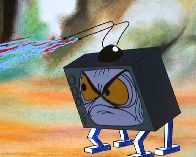The Rebirth of Mobile Television?
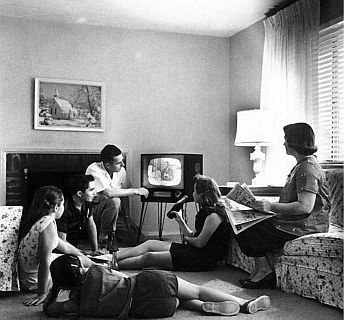 The first form of instant mass communication was the radio, and to receive radio programmes you had to have an enormous box which sat in the corner of the room, gave off a fair amount of heat and wasn't in the least bit portable. With the invention of the mass-production transistor in the 1950s however, radios were able to shrink to a far smaller size and run off batteries. Soon they were everywhere: cars began featuring radios as standard, people would take a radio with them into every room of the house (even the bathroom!), and no picnic was complete without a transistor set. The portable radio was a huge success and continues to be one today as a ubiquitous component of car stereo systems, mobile phones and MP3 players.
The first form of instant mass communication was the radio, and to receive radio programmes you had to have an enormous box which sat in the corner of the room, gave off a fair amount of heat and wasn't in the least bit portable. With the invention of the mass-production transistor in the 1950s however, radios were able to shrink to a far smaller size and run off batteries. Soon they were everywhere: cars began featuring radios as standard, people would take a radio with them into every room of the house (even the bathroom!), and no picnic was complete without a transistor set. The portable radio was a huge success and continues to be one today as a ubiquitous component of car stereo systems, mobile phones and MP3 players.
The next major advance in broadcasting technology was the television, which, like radio, spent its formative years lurking in people's living rooms like some enormous glass and mahogany beast, glowing with wasted energy thanks to its pre-transistor technology. The post-War development of electronics also revolutionised the design of televisions, making them more reliable, less heavy and less power hungry. Eventually, it was assumed, it would follow the trail blazed by the portable radio and become portable itself, and indeed the technology did eventually appear to make this a practical proposition in the late 1970s and early 1980s. As time went on the technology got better and better, but for some reason the heralded mobile television revolution never took place. A few people bought them, but most people didn't, and the pocket TV has remained something of a luxury or novelty ever since it first went on sale over 20 years ago. They seemed exciting but it was rare to see people actually using them in public, despite the best efforts of companies such as Sinclair (who even made a wrist-watch sized TV) and Sony (who had just had enormous success with their pioneering portable cassette Walkmans).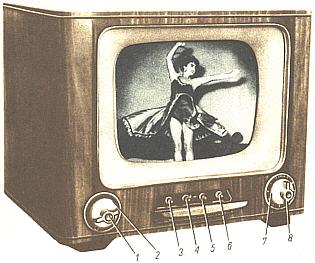 It's often assumed that the pocket television sold in relatively small numbers because it couldn't provide the sort of ambient experience that radio is so good at. No one wants to stare at a screen while trying to concentrate on something else such as driving or walking, so radio remained the traveller's companion of choice. Also, the smaller picture size on a pocket TV made for a less satisfactory experience than watching something at home on a normal TV, whereas radio was unaffected by the size of its receiver. These explanations would have been completely satisfactory until 1989, but then a portable console called the Nintendo Game Boy was released which physically resembled a pocket TV and required far more concentration from its user than simply watching the screen. The Game Boy was a huge hit and spawned an entire industry which is now bigger than ever (the PlayStation Portable and Nintendo DS wouldn't exist if it wasn't for the success of the original Game Boy). If people were willing to spend a lot of time and money playing on portable consoles, what was stopping them watching portable televisions which cost about the same amount and weighed about the same?
It's often assumed that the pocket television sold in relatively small numbers because it couldn't provide the sort of ambient experience that radio is so good at. No one wants to stare at a screen while trying to concentrate on something else such as driving or walking, so radio remained the traveller's companion of choice. Also, the smaller picture size on a pocket TV made for a less satisfactory experience than watching something at home on a normal TV, whereas radio was unaffected by the size of its receiver. These explanations would have been completely satisfactory until 1989, but then a portable console called the Nintendo Game Boy was released which physically resembled a pocket TV and required far more concentration from its user than simply watching the screen. The Game Boy was a huge hit and spawned an entire industry which is now bigger than ever (the PlayStation Portable and Nintendo DS wouldn't exist if it wasn't for the success of the original Game Boy). If people were willing to spend a lot of time and money playing on portable consoles, what was stopping them watching portable televisions which cost about the same amount and weighed about the same?
Perhaps the problem was a range of technologies which simply wasn't ready in the 1980s and 1990s: older LCD screens suffered from ghosting (where a moving image is blurred), backlit screens used up batteries very quickly, and the very low picture resolution made text unreadable on most pocket TV models. All of those problems have since been fixed partly thanks to the immense amount of money poured into mobile phone research. Small LCD screens can now have crisp high-resolution moving pictures and use relatively little power. Yet the pocket TV market remains a niche, and while everyone has a portable radio somewhere in their house, very few people have a portable television.
Is there something innately unappealing about watching television on a portable device? Are all attempts to make money from pocket-sized televisions doomed from the start?
Television on Mobile Phones
Despite the rather dark omens from previous attempts at popularising mobile television, a number of different approaches have been taken to getting programmes from the small screen onto the even smaller one you find on mobile phones. Some rely on direct broadcasts just like normal televisions, some use internet-based video channels delivered through a 3G connection, and some use ordinary home television channels which are retransmitted and controlled through 3G in a process which some call "location-free television" or "location shifting television".
In its favour, the concept of mobile phone-based TV does have one huge advantage over other portable television systems: almost everyone has a mobile phone. This sounds like a silly thing to point out, but it's the main reason why phenomena such as text messaging have become so widespread. Two-way pagers had already allowed texting for some time but failed to find much of a market because that was the only function the device had, and most people didn't buy it.
If people are already buying and carrying television-capable 3G phones in large quantities anyway, then it's not such a huge task to convince them to click a few buttons and try whatever TV service is offered to them.
There is also some evidence from surveys (such as this one in Oxford and this one in Helsinki) conducted during testing of mobile phone television systems which implies that there may be a large potential market for these kinds of services, with most of the people who tested the system having said they'd be interested in subscribing to it.
Mobile Phone Television, The Old Fashioned Way: Digital Broadcasting
 As noted in our article about radio, there's a certain conflict nowadays between programmes sent from a transmitter via direct broadcasting and programmes streamed over the internet through packet-based networks. Both have advantages and disadvantages, but as time goes by it seems the disadvantages of streaming will become smaller and smaller. More on that later.
As noted in our article about radio, there's a certain conflict nowadays between programmes sent from a transmitter via direct broadcasting and programmes streamed over the internet through packet-based networks. Both have advantages and disadvantages, but as time goes by it seems the disadvantages of streaming will become smaller and smaller. More on that later. Transmitters are the old-fashioned way of doing things, they send a radio signal and the receivers receive it, exactly the way the first ever radios and TVs worked. Nowadays however the signal is usually digital as this allows more information to be sent more reliably than analogue signals. Broadcast digital signals intended for mobile phones require that the phone contain a computer fast enough to decode them in real time (modern smartphones have more than enough power to manage the job) but they also require that the phone has compatible receiver hardware, and this is lacking from the vast majority of smartphones worldwide.
Transmitters are the old-fashioned way of doing things, they send a radio signal and the receivers receive it, exactly the way the first ever radios and TVs worked. Nowadays however the signal is usually digital as this allows more information to be sent more reliably than analogue signals. Broadcast digital signals intended for mobile phones require that the phone contain a computer fast enough to decode them in real time (modern smartphones have more than enough power to manage the job) but they also require that the phone has compatible receiver hardware, and this is lacking from the vast majority of smartphones worldwide.
The two main broadcasting standards for mobile television are DVB-H (Digital Video Broadcasting Handheld) and DMB (Digital Multimedia Broadcasting). DMB is also sometimes known as T-DMB and S-DMB. There's no clear winner yet, both systems have major backers, and both systems have had trial launches in various parts of the world, but neither has been properly deployed across an entire region yet. One could try to read the tea leaves about who will win this particular format war, but in practice it's impossible to know until it's happened. The outcome will depend on a complex mixture of consumer fads, technological prowess, government regulation and the influence of backers in persuading people to buy particular handsets and other devices.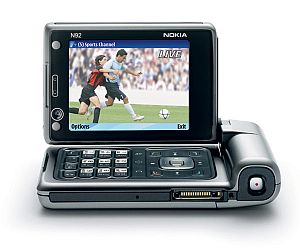 Those who want a more direct technical comparison between DMB and DVB-H ought to check out this excellent article published over the Summer in the Open Gardens blog. It's probably worth noting here though that both systems use existing television and radio transmitters for broadcasting programmes to mobile phones, and wouldn't require much in the way of new infrastructure.
Those who want a more direct technical comparison between DMB and DVB-H ought to check out this excellent article published over the Summer in the Open Gardens blog. It's probably worth noting here though that both systems use existing television and radio transmitters for broadcasting programmes to mobile phones, and wouldn't require much in the way of new infrastructure.
As far as Symbian goes, the only announced model so far is the Nokia N92, which contains a built-in DVB-H receiver and is supposed to be launching around the same time that DVB-H services start operating in Finland at the end of 2006. This hasn't been confirmed, however, and the N92 hasn't entered mass production yet.
Limited trial runs of DVB-H were done around Europe using the Nokia 7710 Series 90 based smartphone, but it had special extra hardware fitted to it in order to receive the broadcasts, the retail 7710 can't receive DVB-H on its own.
However, it could be that both DVB-H and DMB will be made irrelevant by internet-based television, as the internet offers a far wider range of options for viewing video. Internet television also doesn't require any special hardware to be present in the phone except a fast internet connection, so it has a much larger existing userbase, much wider coverage, and none of the uncertainty that a format war brings.
Mobile Phone Television, The New Fangled Way: Internet Streaming
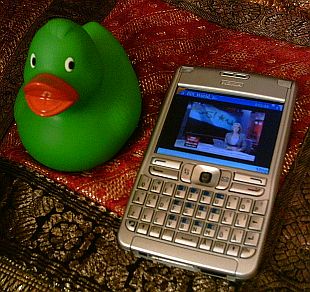 If you checked out AAS's article about the future of radio, you'll know that it's now possible to listen to virtually any major radio station all around the world on your mobile phone via the internet, either using wi-fi or 3G. There's no technical reason why this can't also be done with television, and indeed many phone operators already advertise internet video streams to their 3G customers which can cover live events or allow viewing of videos on demand. Third party companies can and do also offer such services.
If you checked out AAS's article about the future of radio, you'll know that it's now possible to listen to virtually any major radio station all around the world on your mobile phone via the internet, either using wi-fi or 3G. There's no technical reason why this can't also be done with television, and indeed many phone operators already advertise internet video streams to their 3G customers which can cover live events or allow viewing of videos on demand. Third party companies can and do also offer such services.
I tried a 3G streamed television service currently available for free from my mobile network operator on a Nokia E61. Unfortunately my monthly payment for unlimited internet access is the cheapest possible so my connection had a speed cap of 128 kbps, which meant the picture had to buffer every few minutes. Putting that aside though, the service was good, the programmes were completely watchable and it was actually a really good way to pass the time. Screens on smartphones like the E61 really are good enough to watch TV on, displays have developed in leaps and bounds since the days of fuzzy pocket TVs in the 1980s and 1990s. I still wouldn't recommend watching wide-screen films on a portable device, but programmes designed for television work fine.
The service is accessed very simply by just going to the operator's WAP-site and clicking on the links to various channels, which automatically spawn the RealPlayer application and load up the relevant stream. It's also possible to select pre-recorded programmes as well as live channels, which on this phone network's service meant the latest news bulletin was available for viewing after its live broadcast. This could easily be expanded to cover lots more programmes, indeed this ought to be done as it would give the service a useful feature that would be impossible on its broadcast rivals such as DVB-H and DMB. It would require no more bandwidth to provide streams on demand than streams live, so there's not really any technical limit to the number of programmes that could be made available as video-on-demand through internet television.
If the buffering is absent on higher speed caps and the fee for the service is reasonable I could see a lot of people using something like this. Television can be entertaining on modern mobile devices, and the ability to watch video on demand is another potential "killer app". Imagine forgetting to watch the latest episode of your favourite soap: this technology could allow you to watch it during your train journey in the morning, catching up on your television just like you might catch up on your emails.
The current drawback to unlimited work-anywhere 3G channels is the cost. Many phone networks still charge an arm and a leg for mobile internet access, and streamed video is the most expensive way of using the internet. However, this is changing as flat rate and cheap rate internet access becomes available from more and more network operators. Mobile internet access is getting cheaper everywhere and in some countries it already costs as little as €10 a month for uncapped mobile internet access.
The Third Way: Broadcast TV and Internet TV working together
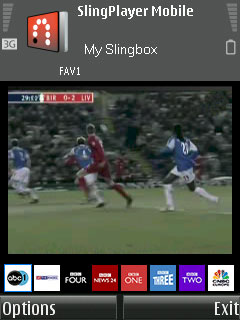 You might well have a decent television set up at home: a digital satellite or cable service with hundreds of channels, or even just a humble digital terrestrial receiver with dozens of channels. Wouldn't it be great if you could watch any of those channels through your phone, anywhere in the world?
You might well have a decent television set up at home: a digital satellite or cable service with hundreds of channels, or even just a humble digital terrestrial receiver with dozens of channels. Wouldn't it be great if you could watch any of those channels through your phone, anywhere in the world?
Well, you can. In a process dubbed "Location Free Television" or "Location Shifted Television", a special box is connected to whatever you use to watch television, your cable, satellite or terrestrial decoder, or even your PVR. The special box also has to have access to a broadband internet connection. Once this is done, the box lets you control and view the signal from your home television's decoder or PVR entirely through your phone's internet connection wherever you are on the planet, with the picture automatically scaled down so it suits the size of the device you're using.
The first such system to support Symbian is called SlingPlayer Mobile and is due to be released by Christmas 2006. AAS's Steve Litchfield conducted an interview with a representative of Slingmedia at the Symbian Smartphone Show, during which the SlingPlayer software was demonstrated streaming a local TV channel from California on a Symbian S60 smartphone in London through a 3G connection. The SlingPlayer Mobile software connects to your television through a device called a Slingbox, which also allows you to watch your TV channels on a broadband-connected PC anywhere in the world.
Who will win?
It's impossible to know which system will become most popular in the short or medium term. It's possible that no one system will be globally popular, and indeed there never has been one "winner". Television looked at globally is an odd patchwork of terrestrial, cable and satellite broadcasting with internet television starting to put in an appearance too.
In the long term however, it seems likely that internet-based broadcasting will become the main way that people will watch television programmes. The internet places no restrictions on the number of channels or the physical range within which a channel can be seen, and it also allows viewers to watch an unlimited number of programmes on demand. Indeed it may be that, with the exception of live sports events and news services, people will generally move towards watching particular programmes rather than switching on particular channels. We've already had a taste of how popular this can be with the huge number of people who use YouTube, albeit mostly to watch pirated material.
If such an approach to TV becomes the standard, then a service based around a high speed mobile internet connection will be the only way of making it happen on mobile devices. DVB-H and DMB will become irrelevant stopgap technologies from an era when mobile internet access was still slow and expensive. Devices such as the Slingbox would become irrelevant because there would be no need to go through them to stream material, you'd be able to stream directly from the broadcasters.
The one problem with internet TV is this: if everyone can get their programme on 'television', how will you tell the rubbish from the good stuff? It's bad enough on digital services with hundreds of channels, most of which are shopping or quiz-based, but the situation when there are an unlimited number of services vying for your attention will be overwhelming for most people. Clearly some trusted guides will be needed, and it could be that most of us will go right back to a small number of content recommendation services run by various reputable organisations and companies.
Maybe we really just want a few decent channels, as it was in the 1960s.....
krisse, 29 Nov 2006

